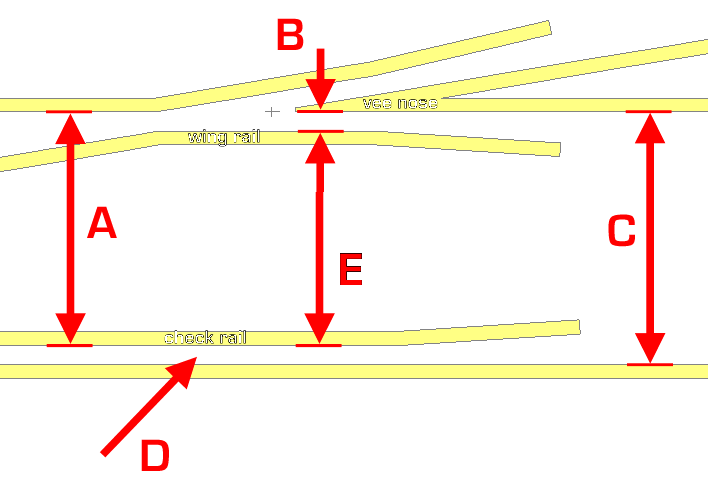Dimensions for 00-SF
00-SF is also known as 4-SF or "EM minus 2" - from an original idea by Roy Miller in 1973
These dimensions were derived for 00 use by subtracting 2.0mm from the dimensions published by the EM Gauge Society (EMGS) in 1970.
For EM add 2.0mm to all relevant dimensions below.
Martin Wynne
| TRACK: | ||||
| A | check gauge | 15.2 mm | MINIMUM | This dimension must not be less than 15.2mm. There is no maximum, but if other dimension limits are met it will not be possible to exceed 15.2mm significantly. |
| B | crossing flangeway gap | 1.05 mm | MAXIMUM | If prototypical blunt-nose vees are used, this dimension must not exceed 1.05mm. There is no minimum, but it will not be possible to make it significantly less than 1.0mm if other dimension limits are met. This dimension is normally set as close as possible to 1.0mm by making it a close fit on the 1.00mm gauge shim. |
| E | check span | 14.25 mm | MAXIMUM | The span across the wing rail and check rail must not exceed 14.25mm. There is no minimum. |
| C | track gauge | 16.2 mm | MINIMUM | The track gauge must not be less than 16.2mm. It can be widened where necessary on sharp curves. |

A is the check gauge. It is the most critical dimension in pointwork. If this dimension is too small, wheels running from left to right can hit the nose of the vee and very likely derail, or at least bump. If this dimension is too large, the wheel backs will bind or jam on the check rail. To make sure it's correct, the check rail is set using check gauge tools. For 00-SF and 00-BF this dimension should be 15.2mm.
You can use the same check gauge tools for both these standards, and also for 00-MF and 00-IF (they are all running the same wheels).
B is the crossing flangeway gap. It's also important. If this dimension is too small, the wheel backs will bind or jam on the wing rail. If this dimension is too large, the gap in front of the nose of the vee will be too wide, and the wheels may drop into it with a bump. This gap is set using a small piece of metal shim called a crossing flangeway gauge shim. For 00-SF it should be 1.0mm thick. For 00-BF it should be 1.3mm thick.
C is the track gauge. It shouldn't be less than the specified dimension, but it can be wider. It is often widened on sharply curved track to ease the running of long-wheelbase vehicles. The track gauge is normally set using roller gauge tools, or alternatively using a 3-point gauge tool, which automatically widens the track gauge on sharp curves. For 00-SF this dimension shouldn't be less than 16.2mm. For 00-BF it is normally 16.5mm.
D is the check rail gap. The width of this gap doesn't matter, providing it is wider than the wheel flanges. It's whatever you end up with after setting A and C correctly.
(But where the check rail is combined with a wing rail in complex formations such as a tandem turnout -- i.e. in parallel-wing V-crossings -- it must be the same as B.)
E is the check span. It is not usually necessary to set this dimension directly if the gauges are used correctly. For 00-SF this dimension shouldn't be more than 14.25mm. For 00-BF this dimension shouldn't be more than 14.0mm.
| WHEELS: | ||||
| back to back | 14.3 mm | MINIMUM | Wheel spacing must not be closer than this, otherwise the wheels may jam or bind across the check span. | |
| back to effective flange | 15.2 mm | MAXIMUM | This dimension must not exceed 15.2mm otherwise wheel flanges may strike the crossing nose and bump or derail. For optimum running wheels should be set as close to this maximum dimension as possible, without exceeding it. | |
| wheel width | blunt-nose crossings: 2.3 mm sharp-nose crossings: 2.1 mm |
MINIMUM | If wheels are narrower than this there is a risk they may drop into the crossing gap. There is no maximum. | |
| flange thickness | 0.8 mm | MAXIMUM | The flange thickness must not exceed 0.8mm to clear the flangeway gap, and to ensure sufficient running clearance between the rails on plain track. There is no minimum. | |
back to: main page